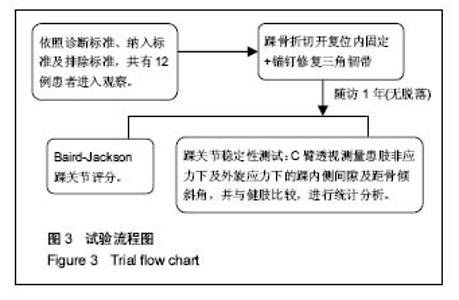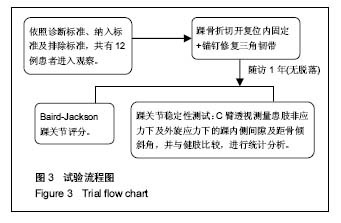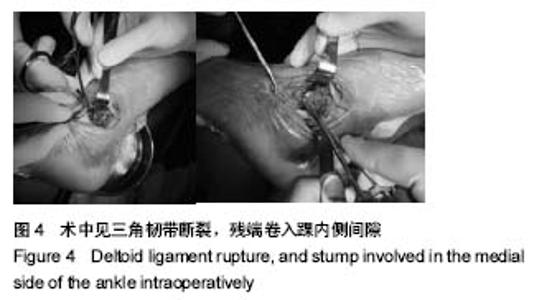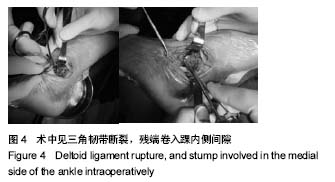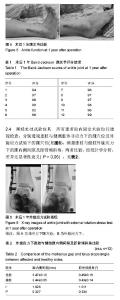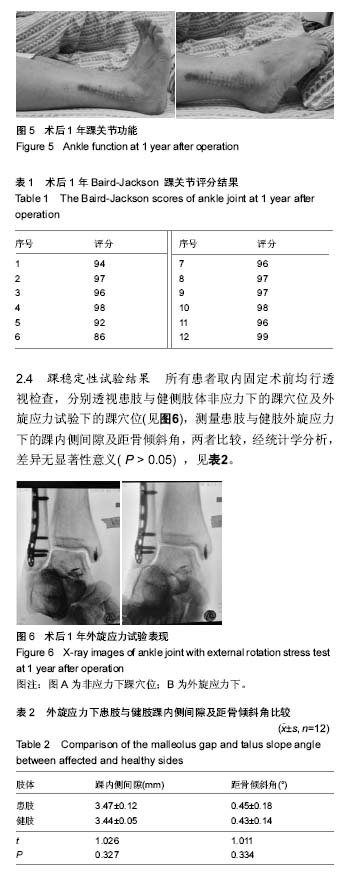| [1] 庞增林,李兴勇,宋敏.踝关节骨折脱位的治疗进展[J].中医临床研究,2015,7(5):146-148.[2] 喻单根,张建河,吕飞,等.漂浮体位下手术治疗三踝骨折[J].中国骨与关节损伤杂志,2015,27(S1):52-53.[3] 王满宜.足与踝骨折的几个问题[J].中华创伤骨科杂志,2006,8(5): 401- 403.[4] 陆宸照.踝关节损伤的诊断和治疗[M].上海:上海科学技术文献出版社, 1998:108-109.[5] 徐海林,徐雷,张培训,等.踝关节三角韧带损伤的手术治疗[J].北京大学学报(医学版),2013,45(5):704-707.[6] 车健,刘玉杰,纪斌平.慢性下胫腓联合损伤研究进展[J].中国药物与临床,2017,17(1):62-66.[7] 田勇,马骁.带线锚钉修复三角韧带损伤:恢复踝关节稳定性[J].中国组织工程研究,2015,19(22):3565-3570.[8] 童琦,吴作培,孙贵新.踝关节三角韧带损伤诊疗进展[J].国际骨科学杂志,2015,36(2):105-108.[9] 刘彬,陈志伟,吴文特,等.急性踝关节三角韧带损伤的诊疗进展[J].中国骨与关节杂志,2016,15(10):779-782.[10] Schuberth JM,Collman DR,Rush SM,et al.Deltoid ligament integrity in lateral malleolar fractures:acomparative analysis of arthroscopic and radiographi cassessments.J Foot Ankle Surg. 2004;43(1):20-29.[11] Swenson DM,Collins CL,Fields SK,et al.Epidemiology of U.S.high school sports-related ligamentous ankle injuries,2005/06-2010/11.Clin J Sport Med.2013;23(3): 190-196.[12] 友斯飞,徐向阳.外踝骨折合并三角韧带损伤的临床检查及诊断[J].临床和实验医学杂志,2011,10(21):1716-1717.[13] van den Bekerom MP,Mutsaerts EL,van Dijk CN.Evaluation of the in-tegrity of the deltoid ligament in supination external rotation ankle frac-tures: a systematic review of the literature.Arch Orthop Trauma Surg.2009;129(2): 227-235.[14] 石颖会,陈东栋,张可.踝关节骨折伴三角韧带断裂的手术治疗[J].中国中西医结合外科杂志,2016,22(6):601-603.[15] 林郁,叶清寿,李均保,等.带线锚钉内固定治疗踝部骨折伴三角韧带损伤15例分析[J].福建医药杂志,2015,37(3):175-176[16] Michelson JD,Varner KE,Checcone M.Diagnosing deltoid injury in ankle fracrures:the gravity stress view.Clin Orthop Relat Res.2001;6(387):178-182.[17] Femino JE,Vaseenon T,Phistkul P,et al. Varus external rotationstress test for radiographic detection of deep deltoid ligament dis-ruption with and without syndesmotic disruption: a cadaveric study. Foot Ankle Int.2013;34(2):251-260.[18] 郑文林,范伟锋,陈捷军.踝关节骨折脱位并三角韧带损伤的治疗探讨[J].海南医学,2011,22(5):39-41.[19] Tornetta P 3rd.Competence of the deltoid ligament inbimalleolar ankle fractures after medial malleolar fixation.J Bone Joint Surg Am.2000;82(6):843-848.[20] Henari S,Banks LN,Radovanovic I,et al.Ultrasonographyas a diagnostic tool in assessing deltoid ligament injury in supination external rotation fractures of the ankle. Orthopedics. 2011;34(10):e639-e643.[21] 高武长,王英振.切开复位内固定踝关节骨折:联合带线锚钉修复三角韧带损伤的意义[J].中国组织工程研究,2016,20(9): 1255-1260.[22] Milner CE,Soames RW.The medial collateral ligaments of thehuman ankle joint: anatomical variations.Foot Ankle Int.1998;19(5): 289-292.[23] 苏应军,童新延,胡力.踝关节骨折伴三角韧带损伤应用手术治疗的临床分析[J].临床医学工程,2016,23(7):919-920.[24] Earll M,Wayne J,Brodrick C,et al.Contribution of the deltoid ligament to ankle joint contact characteristics:acadaver study. Foot Ankle Int.1996;17(6):317-324.[25] 黄少辉,陈添,李兰泉, 等.踝关节骨折86例手术治疗体会[J].广东医学院学报,2014,32(1):73-75.[26] 施凤超,周敦,朱文峰, 等.双固定锚钉治疗踝关节三角韧带损伤的疗效分析[J].江苏医药,2014,40(10):1215-1216.[27] 代加楠,杨志奎,曹熙, 等.踝关节骨折合并三角韧带损伤手术中修复三角韧带与不修复对于预后的影响[J].生物骨科材料与临床研究,2016,13(2):40-43.) [28] 王海鹏,顾峥嵘,刘云吉, 等.手术治疗踝关节骨折伴三角韧带损伤的疗效观察[J].中国修复重建外科杂志,2015,29(4):416-419.[29] 梁文清,翁东,徐国健, 等.缝合锚钉治疗踝关节三角韧带附着点断裂疗效观察[J].临床骨科杂志,2014,17(5):579-582.[30] 陈农,李智,董健,等.应用缝合锚钉治疗踝关节三角韧带损伤[J].中国骨与关节损伤杂志,2011,23(7):650-651.[31] 丁磊,吴靖平,李德芳, 等.锚钉修复外踝骨折合并三角韧带损伤的疗效[J].中国临床医学,2012,19(3):266-267.[32] Lack W,Phisitkul P,Femino JE.Anatomic deltoid ligament re-pair with anchor-to-post suture reinforcemet: technique tip.Iowa Orthop J.2012;32: 227-230.[33] Burns WN, Prakash K, Adelaar R, et al.Tibiotalar joint dynamics:indications for the syndesmotic screw--a cadaver study.Foot Ankle.1993;14(3):153-158.[34] 王晨,马昕,王旭,等.外踝骨折后三角韧带完整性对踝关节稳定性影响的CT三维重建研究[J].中华骨科杂志,2013,33(10):1058-1064.[35] 伍凯,林健,黄建华,等.急性踝关节骨折伴三角韧带损伤术中诊断及治疗策略[J].国际骨科学杂志,2015,36(2):141-145.[36] 何河北,董伟强,孙永建,等.修复三角韧带与不修复对于踝关节骨折合并三角韧带损伤术效果的Meta分析[J].中华关节外科杂志: 电子版,2014 ,8(4):497-501. |
